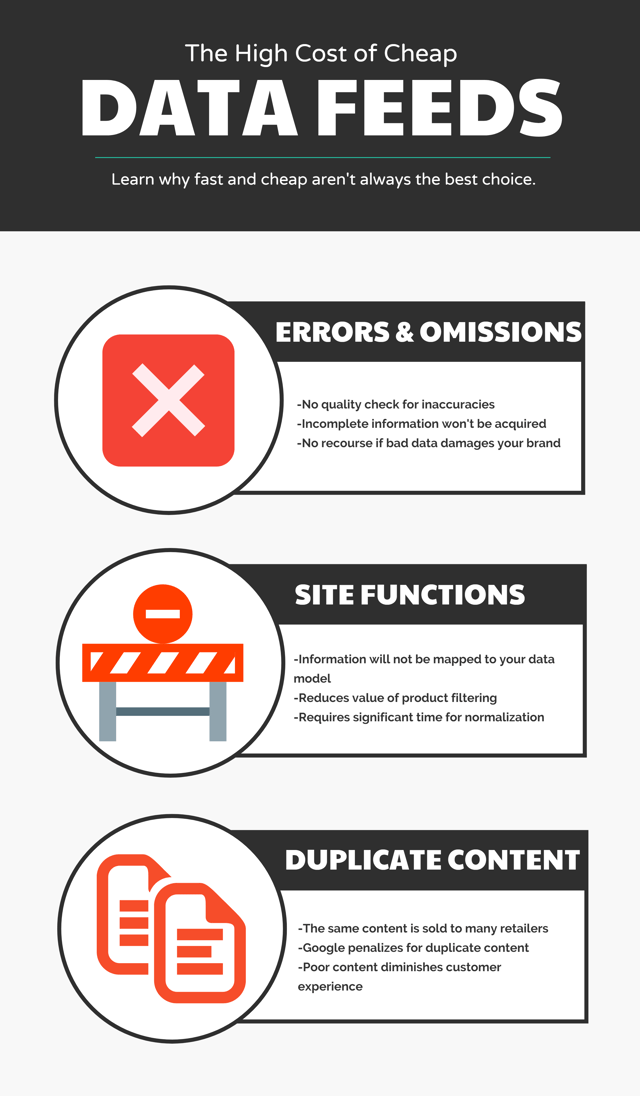Like most retailers, you prize efficiency. You've explored a number of ways to save time and money, and data feeds are on your radar, whether you use them today or have considered doing so in the future. Product data feeds provide fast, easy access to product information at low prices, making them a compelling option for your e-commerce site.
Unfortunately, the money you save by using data feeds can result in serious costs over time, as well as real damage to your brand's reputation and the overall customer experience you offer current shoppers.
Not all product data management solutions are created equal. Read on to learn more about the hazards of relying on data feeds to acquire product attributes and how today's cheap, easy solution can quickly become tomorrow's e-commerce headache.

Where do product data feeds come from?
The low cost of data feeds can typically be attributed to the reduced labor cost of offshore workers. While you may locate quality data sources from overseas providers, it's important to remember that the employees creating the feeds are likely to have minimal knowledge of the products in question. This often results in inaccuracies and, when coupled with a considerable language barrier, is a recipe for mistakes and omissions.
It's also likely that the product information you receive was not collected from the manufacturer. Instead of investing the time necessary to build a relationship with manufacturers and acquire rich, detailed product information, data feed companies frequently rely on data used on other e-commerce sites, such as Amazon, Walmart or eBay. That means you could receive sparse product attributes that exclude key details and inherit errors introduced by another retailer.
Unfortunately, there's no way for retailers to hold most data feed providers accountable for the information they receive. Most contracts include clauses that remove responsibility for inaccuracies and incomplete information, meaning that any data you receive through feeds is purchased as-is with no recourse when problems arise. Because speed and affordability are the top priorities, data is compiled without clear quality standards in place and delivered without regard for the potential negative impact on the retailer.
And that negative impact can be profound. Over the years we've partnered with many retail clients who saw sales decline and customer care issues rise due to bad data. Audits of their sites revealed factual errors in as many as 65% of all product records, plus as many as 15% of records missing key assets, including attributes and images. Once you consider these statistics, the low price of data feeds no longer seems so appealing.
Product attributes make or break site functionality
Consistently formatted and populated product attributes drive many e-commerce site functions that consumers depend on for a better shopping experience. When those functions depend on data feeds, a host of problems can plague your left-hand navigation, comparison features and the ability to view related items, all of which are essential to growing conversions.
In most cases, a feed is simply a compilation of the product content and attributes as they were found at the source with minimal intervention. That means your team will need to map, normalize and cleanse data before it can be used to support essential site functions.
Consider the example of product data for HDTVs. Product attributes are often identified differently from brand to brand, meaning that your assortment could contain screen size information called out as Screen Size, Diagonal Screen Size and TV Screen Size. The result? Every attribute name must be reviewed and mapped to the product attribute in your data model before the information can be used.
This same issue will apply to the data itself. 50" TVs from different brands may be called out as 50", 50 in., 50 inches, 50, 50-55" and so on. Using these values without corrections would result in five different filterable values on your site, preventing every TV in the 50" class from displaying under the same filter and making it much harder for customers to compare products and browse your full assortment. You'll be left with the choice of diminishing customer experience or spending even more time normalizing data before it can be used and significantly lengthening your expected time to market.
Don't forget about the value of unique product descriptions
It's also important to keep in mind that the information you receive from a data feed has been sold to many other online retailers. Publishing the content on your site verbatim further diminishes user experience, because you're not offering anything to distinguish you and your products from the competition.
Google will also take notice of the use of duplicate content. Unique content is just as important for search engine algorithms as it is for consumers, and your site will be penalized when you publish the same information over and over again. That means a lower position on the SERP, reduced opportunity for customers to discover your offerings via organic search and lower conversion rates over all.
Are the savings of data feeds worth the risks they present? In the long run, an investment in quality product information is an investment in your brand's growth. Online retail is an increasingly crowded marketplace, and consumers are aware that they have more shopping options than ever before. By presenting them with accurate, normalized data, rich product pages and site functions that simplify the decision process, you'll soon see benefits that outstrip whatever costs you're able to cut by relying on inferior data.
Successful online retail depends on good product data management. That's why we offer a managed product data service that streamlines the item onboarding process. Contact us today to see how Virtucom Group can deliver results for your e-commerce site.



.jpg)

